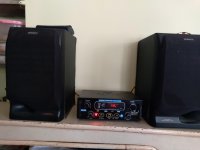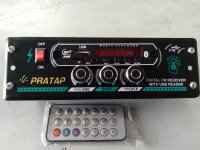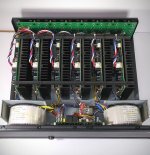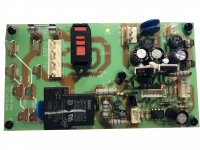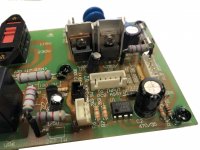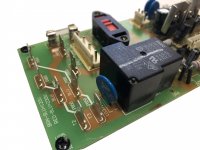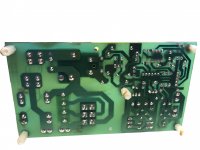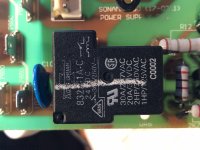Hello,
Issue:
All of a sudden through my speakers I am getting a loud buzzing sound. This is on all the channels.
I read that possibly it can be a lifted ground wire. To verify I tried a power cord with no ground, seeing if bypassing may work. Still buzzing.
I looked at the power supply board, and I am not seeing any blown capacitors. What else can I try to diagnose. Since on all channels, should be a power supply issue?
Thank you for any help.
JR
Issue:
All of a sudden through my speakers I am getting a loud buzzing sound. This is on all the channels.
I read that possibly it can be a lifted ground wire. To verify I tried a power cord with no ground, seeing if bypassing may work. Still buzzing.
I looked at the power supply board, and I am not seeing any blown capacitors. What else can I try to diagnose. Since on all channels, should be a power supply issue?
Thank you for any help.
JR
Your amplifier is already fitted with a ground lift switch it isolates the audio circuit from the chassis it looks like a processor controlled amplifier although I have not seen a schematic.
The loud buzzing does sound like a power supply problem but if the amplifier power supply is a SMPS it could be coming from it.
The loud buzzing does sound like a power supply problem but if the amplifier power supply is a SMPS it could be coming from it.
Hello,
Thank you very much for the reply. Any suggestions on narrowing down the issue on the power supply. I pulled it out, and see no damaged to capacitors or any burn marks from a short.
Thank you
Thank you very much for the reply. Any suggestions on narrowing down the issue on the power supply. I pulled it out, and see no damaged to capacitors or any burn marks from a short.
Thank you
There is one non technical ,easy way to discount if its your mains supply--- plug it into a friends supply or neighbor , that's the easy but sociability is required.
Last edited:
Rectifiers sometime fail but usually it's the main supply capacitors (yes, the big expensive ones) in conventional, transformer+rectifier power supplies and the resulting buzz is of course, unbearable. Capacitors don't have to bulge and burst their seams or leak electrolyte to be in bad shape though. The manufacturer's quality assurance scheme is almost as likely the issue and the problem could even come down to sub-standard materials.
As you can remove the power supply and if there is no large and heavy power transformer anywhere either, I'd assume it is an SMPS type supply that you removed. These are even more critical with their capacitor quality rather than size and they are particularly dangerous to service and test. This a powerful 12 x 30W per channel amp and Unless I was well experienced at working with high energy, high voltage circuits, I'd either replace it with similar rated supply or get a pro. to undertake any repairs.
I read that the Sonance 1230 amp. is rated at 12channels of 30W/8 ohms and The RRP is just US $289? You may want to think about alternatives as well.
As you can remove the power supply and if there is no large and heavy power transformer anywhere either, I'd assume it is an SMPS type supply that you removed. These are even more critical with their capacitor quality rather than size and they are particularly dangerous to service and test. This a powerful 12 x 30W per channel amp and Unless I was well experienced at working with high energy, high voltage circuits, I'd either replace it with similar rated supply or get a pro. to undertake any repairs.
I read that the Sonance 1230 amp. is rated at 12channels of 30W/8 ohms and The RRP is just US $289? You may want to think about alternatives as well.
How many output voltages from that supply?
2 x 30 watts is 5 Amps off 12 volts, not much compared to a PC-AT supply of 450 W or higher.
Change the main smoothing caps, particularly if they are poor quality Chinese, with good ones.
Or save yourself the trouble and put a reputed brand one like Meanwell, possibly try for the next higher rating.
And look for dry solder joints with a magnifying glass, the hum could be mild arcing from a dry joint, which means reworking all the joints with preferably leaded solder, there are horror stories about bad quality solder in cheap Chinese electronics.
2 x 30 watts is 5 Amps off 12 volts, not much compared to a PC-AT supply of 450 W or higher.
Change the main smoothing caps, particularly if they are poor quality Chinese, with good ones.
Or save yourself the trouble and put a reputed brand one like Meanwell, possibly try for the next higher rating.
And look for dry solder joints with a magnifying glass, the hum could be mild arcing from a dry joint, which means reworking all the joints with preferably leaded solder, there are horror stories about bad quality solder in cheap Chinese electronics.
Both use similar FM modules, with Aux, SD card, USB, Bluetooth inputs.
They even have an equalizer function on the remote.
Both use copied 4440 as the main amp.
Loud enough for me. Clear too.
Car radio I changed to stereo tone controls, put a bigger heat sink, and drilled holes in the box for ventilation. Use it with a memory stick, handles 32GB drives.
They even have an equalizer function on the remote.
Both use copied 4440 as the main amp.
Loud enough for me. Clear too.
Car radio I changed to stereo tone controls, put a bigger heat sink, and drilled holes in the box for ventilation. Use it with a memory stick, handles 32GB drives.
Last edited:
That's 12 channels, not just 2 because its a distribution amplifier for home and commercial installations and it's much larger than a small stereo car radio. http://en.all-specs.net/model/705142/ 😉
The unit looks like 6 stereo amps, all with individual lower voltage supplies on each channel.
So the fault could be on the primary side of the toroids.
Start there.
Or the common pre amp section. There is a small transformer on the board between the transformers, and what look like relays. Those could be faulty. Buzz could be from chattering relay contacts for example.
Oops for the 12 channel mistake.
Mosfet amplifier PCBs with stereo output are about 10$ here, 30-0-30 supply.
So the fault could be on the primary side of the toroids.
Start there.
Or the common pre amp section. There is a small transformer on the board between the transformers, and what look like relays. Those could be faulty. Buzz could be from chattering relay contacts for example.
Oops for the 12 channel mistake.
Mosfet amplifier PCBs with stereo output are about 10$ here, 30-0-30 supply.
Last edited:
Naresh, I think the OP would appreciate some positive, informed assistance with this amplifier rather than talk of DIY substitutes and guesswork. Unfortunately, this model is not widely sold so there may not be an active service agent, service manuals or technical support available either.
Unless DCBUS is already familiar with linear audio amplifier design, it's also going to be tough going if nobody here knows this beast, its design details or parts specs. I suspect we won't even be able to help with a schematic which would make it possible to understand where everything that needs checking is, makes its operation a lot easier to understand and to communicate.
Unless DCBUS is already familiar with linear audio amplifier design, it's also going to be tough going if nobody here knows this beast, its design details or parts specs. I suspect we won't even be able to help with a schematic which would make it possible to understand where everything that needs checking is, makes its operation a lot easier to understand and to communicate.
Not exactly the same but I have a 1250 and was too far damaged to save.
I pulled off the 50V 15,000uF off three of boards to try and reuse - they all measured <12,000uF a couple were in the high 10,000uF.
If it were me… unplug all channels expect 1, and test to see if him is still present.
If it is, I agree with Ian, very likely the large supply caps on the board.
If no buzz, then power down and unplug that board and plug in the next - do same test across all the channels/boards.
I think Ian is on to an AC buzz, bc blown parts would usually give you DC and these amps have a robust over voltage, over current and DC protections.
I pulled off the 50V 15,000uF off three of boards to try and reuse - they all measured <12,000uF a couple were in the high 10,000uF.
If it were me… unplug all channels expect 1, and test to see if him is still present.
If it is, I agree with Ian, very likely the large supply caps on the board.
If no buzz, then power down and unplug that board and plug in the next - do same test across all the channels/boards.
I think Ian is on to an AC buzz, bc blown parts would usually give you DC and these amps have a robust over voltage, over current and DC protections.
Ian, something like this, a 12 channel amp, is not for home use.
Not likely to be widely sold, and expected to be industrial quality with 24 x 7 x 365 service up time. On a PA system, sound quality may not be so good, but OK. And service, if at all, by professionals who either installed it, or in house trained personnel.
The OP said hum across all channels.
What is common is the power supply and the pre amp.
So that is what I suggested.
And if need be, substitutes are available at a lower price than a professional repair.
And if needed, some regular amps can be stacked together, space permitting, as a replacement.
Bullittstang above has or had one, he may be able to give some more details of the circuit and main amp section, the rest of the work then is clearer than earlier.
Not likely to be widely sold, and expected to be industrial quality with 24 x 7 x 365 service up time. On a PA system, sound quality may not be so good, but OK. And service, if at all, by professionals who either installed it, or in house trained personnel.
The OP said hum across all channels.
What is common is the power supply and the pre amp.
So that is what I suggested.
And if need be, substitutes are available at a lower price than a professional repair.
And if needed, some regular amps can be stacked together, space permitting, as a replacement.
Bullittstang above has or had one, he may be able to give some more details of the circuit and main amp section, the rest of the work then is clearer than earlier.
From the posted photo, it seems that AC is supplied to each amplifier, or plain DC, as there are big caps on each board.
What is not clear as to why 2 transformers are used, could be L/R or 3 cards each.
In any case, the checking has to start from what is common, possibly by keeping only one board active.
What is not clear as to why 2 transformers are used, could be L/R or 3 cards each.
In any case, the checking has to start from what is common, possibly by keeping only one board active.
Hello,
Thank you for all the replies. So, trying to understand it all, most likely a power board issue. I do not see any noticeable blown capacitors or any burn marks.
Is the best option to try and replace the larger capacitors and the Song Chaun relay for a start.
Thank you,
JR
Thank you for all the replies. So, trying to understand it all, most likely a power board issue. I do not see any noticeable blown capacitors or any burn marks.
Is the best option to try and replace the larger capacitors and the Song Chaun relay for a start.
Thank you,
JR
Attachments
It seems to be a fridge relay(!)
Start with that.
Be careful, it is a dual voltage unit
If you have a scope, check with that too.
Start with that.
Be careful, it is a dual voltage unit
If you have a scope, check with that too.
The power board does not have a rectifier, so it is really the primary side controller, and the 4558 is used as a comparator?
This confirms my thought that each board has its own rectifier and smoothing section.
The relay says Amps as well as HP, pointing to a motor relay, from the shape too it looks like the relays used is fridge and A/c, actually a nice thing because they have a thermal cut off too.
Take it off the board, check for damaged contacts, the cover comes off quite easily. If okay, the next step is...
If you have another relay with the same coil voltage, use jumper wire or anything else, connect just the coil with daughter boards disconnected, see if the relay buzzes rather than clicks.
No need to connect the primary side, this is to see if the relay has proper supply coming to it.
Then it is a relay supply issue.
And from there see what is happening.
Sometimes it is stupid, a low voltage to the coil, a dry joint and so on making the relay contact intermittent.
The big capacitors are there on each board, all of them could not have failed together.
Here only some sort of supply to the 4558, which may not be original, and a 7815, which usually does a good job.
See the capacitor make, and voltage and temperature ratings.
That gives you a pretty good idea of the construction quality, good ones are 10 times or more expensive than cheap ones.
How old is the unit?
And remove one leg of the MOV to test, that might have gone bad, unlikely though, it is to protect the relay contacts from arcing.
This confirms my thought that each board has its own rectifier and smoothing section.
The relay says Amps as well as HP, pointing to a motor relay, from the shape too it looks like the relays used is fridge and A/c, actually a nice thing because they have a thermal cut off too.
Take it off the board, check for damaged contacts, the cover comes off quite easily. If okay, the next step is...
If you have another relay with the same coil voltage, use jumper wire or anything else, connect just the coil with daughter boards disconnected, see if the relay buzzes rather than clicks.
No need to connect the primary side, this is to see if the relay has proper supply coming to it.
Then it is a relay supply issue.
And from there see what is happening.
Sometimes it is stupid, a low voltage to the coil, a dry joint and so on making the relay contact intermittent.
The big capacitors are there on each board, all of them could not have failed together.
Here only some sort of supply to the 4558, which may not be original, and a 7815, which usually does a good job.
See the capacitor make, and voltage and temperature ratings.
That gives you a pretty good idea of the construction quality, good ones are 10 times or more expensive than cheap ones.
How old is the unit?
And remove one leg of the MOV to test, that might have gone bad, unlikely though, it is to protect the relay contacts from arcing.
Last edited:
There is a user manual describing functions that may not be obvious from images of the PCB, like its remote sensing, auto-on power switching circuit. When in doubt, read the instructions 🙂: https://www.sonance.com/assets/media/files/downloads/1230Manual_Revised_100337.pdf
Also, check out the rear panel connections other than speakers, shown in the images of this listing: 1200W Sonance SONAMP 1230 Multichannel Amplifier #1 | Rhythym | Reverb
Also, check out the rear panel connections other than speakers, shown in the images of this listing: 1200W Sonance SONAMP 1230 Multichannel Amplifier #1 | Rhythym | Reverb
- Home
- Amplifiers
- Solid State
- Sonance Sonamp 1230 Sudden Buzzing Sound
